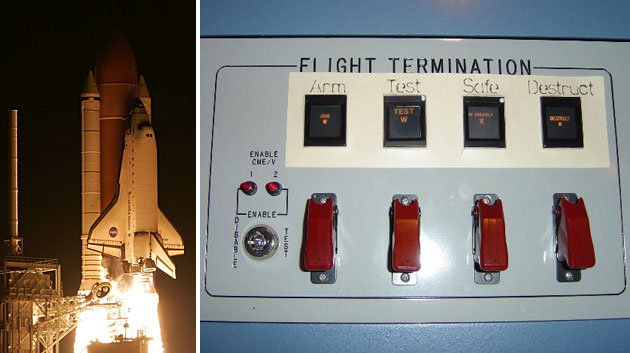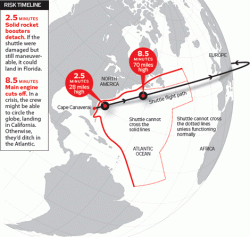This is something I can stomach when considering the launch of an unmanned robotic mission into space. It seems obvious that there should be a “flight termination” switch, especially when considering the damage a malfunctioning rocket could do to populated areas. If mission controllers see the rocket veer off course, they can make a quick and decisive action to blow the launch vehicle, and everything on it, out of the sky. But what about Space Shuttle launches? Surely they don’t have a flight termination option too, do they? Well, yes, they do actually. Welcome to the worst job in NASA: launch safety officer.
Every time the Shuttle launches from Cape Canaveral, there is an Air Force officer overseeing events and will probably be the most nervous person in mission control for the first two minutes of the mission. So who is this officer and what does he/she do? The launch safety officer has very big responsibility, not only to the people in mission control, but to the astronauts on board the launching Shuttle and (most critically) the people on the ground in towns and cities under the flight path. Should the Shuttle spin off course, it could crash, killing hundreds or even thousands of civilians. This is why the Shuttle’s two solid rocket boosters are armed with explosives, linked to the controls at the Air Force officer’s fingertips (pictured top). Flipping one switch would arm the explosives; another switch would detonate the spaceship, killing everyone on board.
I’m sure the safety officer will breathe a long sigh of relief as the Shuttle passes the two minute mark without any problems. At this point, the rocket boosters are jettisoned, taking the explosive charges with them. However, this isn’t the end of the worry for the astronauts.
Should something go wrong after booster separation, they will have limited options to prevent crash landing in a populated area. They can either steer the Shuttle into an orbital path (if it is high enough) and fly over the Earth to line themselves up for an emergency landing at California’s Edwards Air Force Base, or they would have to ditch in the Atlantic Ocean. But that’s not the scary part. Before ditching, the astronauts would have to “bail out” at around 20,000 ft (6,000 meters) without the help of ejection seats. They would need to do it the old fashioned way. “After Challenger, we installed parachutes, survival suits and individual rafts, as well as an extendable pole used to clear the escapees from the wing when they exit the hatch [while in flight],” says Bryan O’Connor, a former shuttle commander and NASA’s chief of safety and mission assurance.
You’ll be glad to hear, the upcoming Orion space vehicle will be kitted out with a special rocket-powered escape pod should the worst happen during launch emergencies.
I’m still shocked that the astronauts need an “extendable pole” to clear themselves from the shuttle as they bail out!
Source: Popular Mechanics



It really is no laughing matter, I’m surprised a better method of bailing out hasn’t been devised. Having said that, give me a slim chance of survival over no chance any day. I just pray this method never has to be used in reality…
After seeing the Challenger disaster, and how the cabin seemed to break away intact, one would have thought that some kind of escape system could have been built in that would have allowed to cabin to detach and use a parachute system to land in the ocean.
“I’m still shocked that the astronauts need an “extendable pole” to clear themselves from the shuttle as they bail out!”
Why?
Now, even that assumes the shuttle is in straight and level flight, (and would not have, say, helped the Challenger crew, had they known what was coming) but it’s a very simple means of insuring they don’t strike the leading edge of the wing as they do so. Other approaches involved complicated ejection systems and pyrotechnics (explosive and/or rocket devices) that would always have been a source of accidental ignition…and also requiring a vehicle still under control and not accelerating.
All this is also because an orbiter is not expected to survive ditching in water, in a situation where no land mass is reachable.
This reminds me of a local (to me) DJ who was astounded that *springs* were used to eject satellite payloads from the shuttle orbiter. Or the matter of developing a pen that could deliver ink to its pall point in zero-g…while the Soviets/Russians used pencils.
If there’s a simple solution to at least part of the problem exists, why not use it?
The original shuttle design, embodied in OV-101 Enterprise, included an escape capsule. But it proved too heavy and it compromised structural integrity. Until the loss of Challenger, there was NO escape mechanism at all. The pole is a pretty sick joke, as anybody who’s really thought about the process knows that the chances of surviving that kind of bailout are somewhere between slim and none.
Esto es algo que puedo soportar cuando se lanza al espacio una misión robótica no tripulada. Parece obvio que debe haber un interruptor de “fin de vuelo”, especialmente cuando se considera el daño que un cohete con una falla podrÃa causar en las áreas pobladas. Si los controladores de la misión ven que el cohete se sale de su curso […] Fuentes: Ian O’Neill para Universe Today y Popular Mechanics.
I would not think that spending the time, money, and extra weight to devise an escape system to such a catastrophic event would be worth while. The men and women who go into space know the risks they are taking just like our soldiers, we should do everything probable to protect them, but does that mean giving every soldier a titanium reinforced tank? The chance of risk and extra cost must be assessed, yes you may have a parachute system but at what cost? Even if the Challenger had a parachute system, would the crew even be able to withstand the g forces placed upon such an explosion?
If the space shuttle were carrying a payload containing a dangerous substance (those used for fuel) at what cost would it be to allow that payload to disburse over Canada or a foreign nation versus terminating the mission over the ocean?
Maybe I’m misunderstanding this process, but I’m assuming this bail out is supposed to occur after they have
a) aborted the launch and decided to ditch in the Atlantic,
b) tried to slow the shuttle a hell of a lot by gliding it at a high angle of attack for a while, and
c) have some sort of emergency autopilot to hold the shuttle as close as possible to such an attitude so they can don their parachutes mid-flight and use this ‘pole’ mechanism to attempt an escape.
Ian writes ‘give me a slim chance of survival over no chance any day’ – I’d say this is not so much a slim chance of survival as a vanishingly small chance!
Remote detonation? That sounds dangerous. I wonder what kind of security mechanisms they employ to make sure no one else can detonate it.
there is only one indicator on the shuttle dashboard that is not labeled…it is the self-destruct indicator that lets the crew know the button has been pushed.
Chuck, that’s harsh
(True-ish, but harsh)
unlike the ‘good ole days’, most astronauts/mission specialists are highly civilians, but civillians, nonetheless.
Consequently, are not quite so as soldiers who are specifiically trained to deal with the fact they may not come back alive from service.
Remember cost considerations lead to the Challenger disaster in the first place.
In assessing risks, does this also mean taking into account slack work & corner cutting?
In such an emergency abort, the shuttle would begin large “S” manuevers to slow speed down to a survivable rate, They would plot a final glide to the ocean and go auto-pilot as they jumped one-by-one.
Now for the pole. That pole is for the survival of the crew more than the survival of an astronaut’s chute caught on the tail-wing horizontal stabalizer. Failure to dislodge the caught jumber from the tail would cause the shuttle to become uncontrollable as the rear ailerons would not be able to function. Straight, level flight allowing the rest of the crew to jump would be lost. The complete crew would likely perish if the first jumper became impossibly entangled in the rear flight controls.
Alphonso,
You are absolutely correct, there should be no “slack work” or “corner cutting” that would put the mission in jeopardy. I also understand the crew minus the pilot is mostly civilian, and some of our brightest minds, however I am sure they prepare themselves mentally prior to launch for the what ifs. If given the option of a possible failure and not going to space, I am sure every one of them would have chosen space. Hopefully we will come to our senses and start pumping more money into R&D and the Space program, as ultimately these funds will create better jobs and increased funding for education.
I am surprised more people do not see the impracticality of spending millions/billions on an escape system that simply puts fears to rest, when in reality the chance of a successful usage is slim to none.
portable teleportation devices–send the crew right back to the ground instantly.
The escape pole system was demonstrated near the end of the movie “Space Cowboys” (James Garner, Tommy Lee Jones, Clint Eastwood, Donald Sutherland).
The speed of the shuttle would be a lot higher than they used in the movie though.